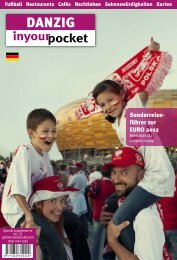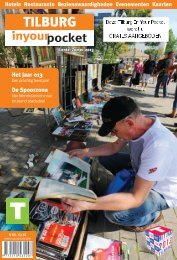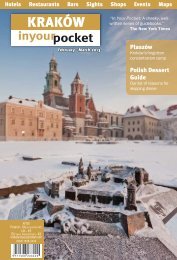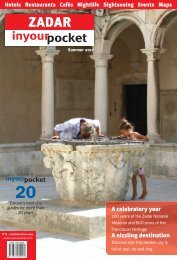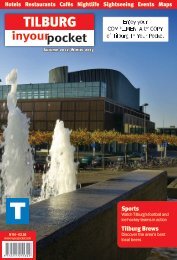7kh 7ul flw\ v prvw dxwkhqwlf 7h[ 0h[ uhvwdxudqw ... - In Your Pocket
7kh 7ul flw\ v prvw dxwkhqwlf 7h[ 0h[ uhvwdxudqw ... - In Your Pocket
7kh 7ul flw\ v prvw dxwkhqwlf 7h[ 0h[ uhvwdxudqw ... - In Your Pocket
You also want an ePaper? Increase the reach of your titles
YUMPU automatically turns print PDFs into web optimized ePapers that Google loves.
106<br />
SOPOT SPA<br />
���������������������������������������������������������<br />
�������������������������������������������������������<br />
���������������������������������������������������������<br />
���������������������������������������������������������<br />
����������������������������������������������������������<br />
���������� ��� ���� ������� �������� ����������� ����� ����<br />
��������������<br />
�������������������<br />
����������������������<br />
������������������������������������<br />
����������������������<br />
�����������������������������<br />
SPA INSTITUTE<br />
Th e beauty treatments menu off ered<br />
by our Spa <strong>In</strong>stitute always respond<br />
to the requirements of our Guest!<br />
Hotel Haff ner, ul. Haff nera 59, Sopot<br />
Tel. +48 58 550 98 53, www.hotelhaff ner.pl<br />
For most foreign visitors Gdańsk is the region’s calling card<br />
but it’s Sopot that has been the region’s primary attraction<br />
for visitors and for the best part of 200 years it was one of<br />
Europe’s premiere health and spa resorts. As with much of<br />
Poland, the city was hit heavily first by the war, then a chronic<br />
lack of capital after. But this has all changed with lower<br />
Monte Cassino receiving a complete facelift. Central to this<br />
multi-million euro development is the latest incarnation of<br />
the Resort House (Dom Zdrojowy) which you will find at the<br />
head of the pier.<br />
The First Resort House<br />
Although there has been recorded settlement here since<br />
1283, the history of spa in the city can be traced back to the<br />
beginning of the 19th century. Attempts were made by the<br />
Carl Christoph Wegner, a Gdańsk patrician, to create a resort<br />
here right at the start of the 19th century. While his attempt<br />
hit a wall, the birth of Sopot (Zoppot, in German) as a spa<br />
resort was close to hand. But it took a Frenchman to make it<br />
work, namely Jean George Haffner. Having discovered Sopot<br />
while moving through Europe as a doctor in Napoleon’s army,<br />
he returned here after the Russian campaign and became a<br />
permanent resident. <strong>In</strong> 1823, he opened the first Bath House<br />
which offered a range of treatments and baths. The first<br />
Resort House was opened in 1824, changing rooms added<br />
on the beach and a small pier built. This opening gambit<br />
was a small, single storied building built perpendicularly to<br />
the beach. The Bath House built the year previous offered<br />
treatments, while the new building served to become the<br />
social HQ for the area with a name for concerts and parties.<br />
Haffner died in 1830, but his legacy didn’t. Stewardship<br />
passed into the hands of the Böttcher family who added<br />
another storey to the Resort House, featuring 12 modest<br />
hotel rooms, while Haffner himself entered folklore, today<br />
revered as the father of modern Sopot.<br />
The Second Resort House<br />
The year 1870 saw a new railway line connecting Sopot<br />
with Berlin, hence sparking a stampede for which the<br />
town was unable to cope with. The projects of Haffner and<br />
Böttcher were simply not able to meet the new demand,<br />
and the council stepped in to the rescue. The existing<br />
buildings were pulled down, and in their place rose the<br />
Second Resort House.<br />
Opened in 1881, this was altogether a larger affair, built<br />
with half-timbered walls, filled with brick and ornamented<br />
with wooden elements. It moved slightly from its original<br />
location and could be found on what is now Powstanców<br />
Warszawy Street). A magnificent vestibule took centre<br />
Postcard showing the terrace of the 3rd Health House<br />
circa 1915. Courtesy of Sopot Museum<br />
Sopot <strong>In</strong> <strong>Your</strong> <strong>Pocket</strong> sopot.inyourpocket.com<br />
stage, opening onto the restaurants and ballroom, forty<br />
hotel rooms were further added, as were spaces for reading,<br />
music and billiards. Spacious walking galleries were added in<br />
1895, as were concert arenas, and a magnificent fountain<br />
unveiled in 1903.<br />
The Third Resort House<br />
Not content with what they had inherited a new set of civic<br />
authorities carried out further renovations to the resort. New<br />
complexes of baths were added in 1903 and 1907, and the<br />
pier extended by 160m in 1910. The Second Resort House,<br />
barely 30 years old, was no longer suitable for the demands<br />
placed upon it, and in 1909 it was levelled to the ground and<br />
replaced by a third.<br />
Although a competition in 1908 had accepted two designs,<br />
these were rejected due to cost and instead Gdansk<br />
architect Carl Weber, was handed the task of designing a<br />
new Resort House. <strong>In</strong> tandem with Adolph Bielefeldt and Paul<br />
Puchmüller, Weber designed and built the new Resort House<br />
which was constructed in record time between September<br />
30th 1909 and 15th June 1910. An impressive complex of<br />
buildings surrounding the Resort Square on all four sides,<br />
the Resort House was moved slightly to the north to allow<br />
the main thoroughfare, Seesstraße (now Monte Cassino)<br />
to reach the sea.<br />
The new Resort House was like nothing that had come before,<br />
containing snazzy mod-cons like boilers, cold storage rooms<br />
and a telephone switchboard. <strong>In</strong> 1919, and with Sopot now a<br />
part of the Free City of Danzig, the famous casino came into<br />
being. This was to become the focal point of Sopot, and not<br />
too different from the bars and ballrooms immortalized by F.<br />
Scott Fitzgerald. And while the Resort House had developed<br />
throughout the 19th century so too had the town around it.<br />
Sopot was experiencing its golden age, and even during<br />
sopot.inyourpocket.com<br />
SOPOT SPA<br />
wartime continued to thrive as the R&R destination of choice<br />
for combatants on leave. This was all soon to change.<br />
The precise story as to what happened when the Red Army<br />
arrived in March ’45 remains murky, though several eye<br />
witness accounts suggest both civilians and soldiers alike<br />
were chased into the sea by an artillery barrage directed<br />
from the hills. What is clear is that after the Soviets entered<br />
Sopot on March 23, 1945, the lower end of Seesstraße<br />
was levelled. The Resort House was not reconstructed<br />
after the war and the ruins were pulled down in 1945-1947.<br />
Only a couple of original elements remained - a single<br />
storied pavilion in the south-western corner the concert<br />
bowl, terraces, fountain and the semi-circular galleries next<br />
to the sea.<br />
Damaged glories were knocked down, replaced instead by<br />
60s and 70s monsters, whose horrid number included the<br />
avant-garde (it was at the time) Alga building which housed<br />
the biggest food outlet on the Baltic. Today you’ll find Szeyk<br />
and Monteka operating from within. Of the other nasty<br />
single storey pavilions that shot up, most were knocked<br />
down in 2006-2007 to make way for the new development,<br />
and are now fondly forgotten as a passing blur from the<br />
communist years.<br />
The Fourth Resort House<br />
The latest incarnation includes around it the Sheraton Sopot<br />
Hotel, a multiplex, conference centre and an impressive<br />
range of bars, cafes and terraces. The development was<br />
formally opened to the public on July 18th, 2009, and will<br />
leave anyone who remembers Sopot of yore doing a double<br />
take. Gone are the shabby pavilions and lego architecture<br />
of the 70s, replaced instead with a sparkling development<br />
that hasn’t foregone the past – the rotunda is a faithful<br />
reproduction, while the fountain is a restored original.<br />
May - July 2012<br />
107



